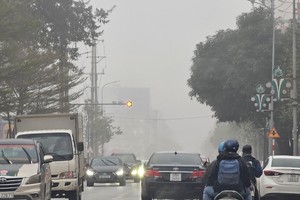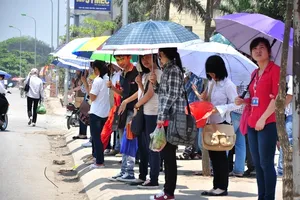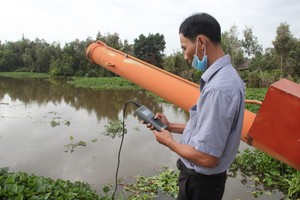Drought and saltwater intrusion have worsened in the Cuu Long (Mekong) Delta this year, threatening rice crops and the daily life of residents.

Le Thanh Hai, deputy director of the National Centre for Hydro-Meteorological Forecasting, said: "Saltwater intrusion [began in] November 2015, one and half months earlier than normal."
The saltwater has reached 50-60km inland, and even 70-80km in some areas, compared to 30-40km in normal years, he said.
Ma Quang Trung, head of the central Plant Cultivation Department, said water levels in southern rivers are at their lowest levels in 90 years.
As a result, saltwater has reached places it had not for the last 90 years, he said.
The drought and saltwater intrusion started when farmers began sowing the winter-spring rice and would last long, meaning the damage is expected to be severe, he said.
More than 950,500ha of the delta's 1.53 million hectares have been affected, according to the department.
Long An, Tien Giang, Ben Tre, TraVinh, Kien Giang, Hau Giang, Soc Trang, and Bac Lieu are the provinces hardest hit, with some of them seeing saltwater encroach on 20-30 per cent of rice-growing areas.
Nguyen Thien Phap, head of the Tien Giang Sub-department of Irrigation and Flood and Storm Prevention and Control, said 700ha of rice crops in Go Cong town and Go Cong Dong and Go Cong Tay districts have been lost due to water shortage, salinity and acid sulfate in soil.
Since January 5 authorities have had to draw water that is saline but with salt content of less than 1.5 grammes per litre from the Tien River to save 30,000ha of rice in the province's eastern region, he said.
Rice can survive if the salt content in the water is less than 2gm per litre.
But the salt content in the Tien River at the Go Cong freshwater zone has reached 2-10gm, many times higher than a year ago.
If prevailing winds are strong and the river's salt content increases in the coming days, water cannot be drawn for irrigation.
The province has 22,000ha of winter-spring rice sowed unusually late and requiring irrigation until the end of March.
But the local Department of Agriculture and Rural Development expects to close the Xuan Hoa sluice gate on March 5, meaning the crop is likely to face a water shortage, Phap said.
Nearly 7,000 households with 35,000 members in Tien Giang's coastal areas lack freshwater for daily use, according to the province People's Committee.
The committee has instructed related agencies to install 122 public taps to provide freshwater for free during this dry season.
It has also used 32 large pumps to pump water from the Tien River into the Xuan Hoa sluice.
The province has also used nearly 1,000 pumps to pump water from large canals into rice fields.
Le Van Huong, chairman of the province People's Committee, on Monday ordered the agriculture department and authorities in districts to carry out various measures like transporting fresh water to houses to ensure there is water for household use and rice cultivation.
The administration plans to use barges to transport water from My Tho city to Chau Thanh District to supply households.
Kien Giang Province, the country's largest rice producer, has suffered the highest rice losses (34,000ha) to drought and saltwater as of early this month.
Trung of the Plant Cultivation Department has told the Kien Giang administration to estimate the damage and seek financial support for farmers from the Government.
His department has instructed affected provinces to strengthen rice field embankments to keep water in and to draw water from rivers and canals to irrigate rice and other crops, he said.
It has also instructed rice farmers to switch to crash crops that require less water in areas without enough water.























